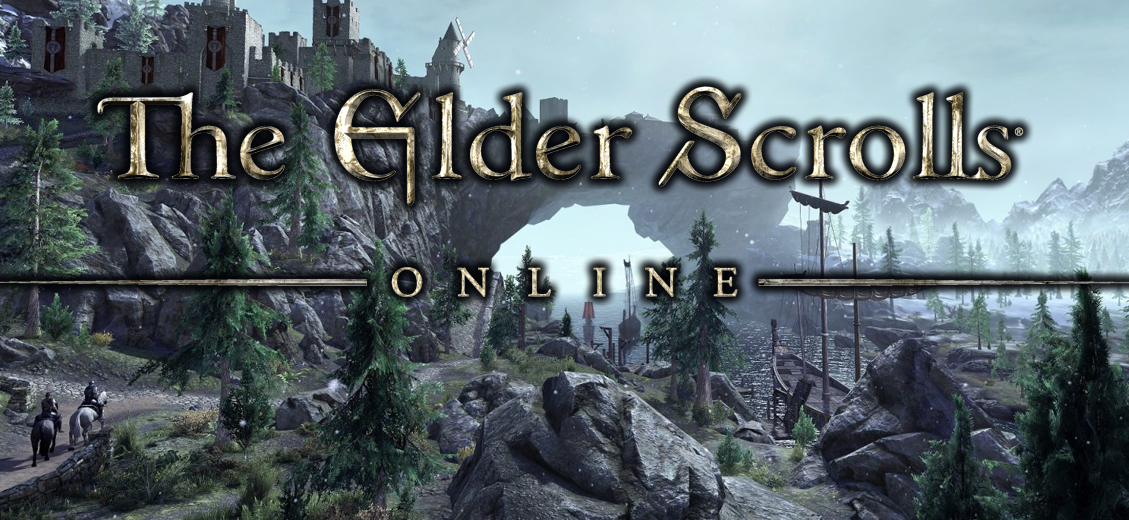Elder Scrolls Online Review 2020 Introduction
The very first Elder Scrolls game was released in March of 1994 as The Elder Scrolls: Arena. Since then, The Elder Scrolls has become one of the most successful fantasy computer game-based series in history. Given the open world design and rich depth of lore and sandbox play style, it was only a matter of time before Bethesda made a MMOG. It has now been more than six years since Elder Scrolls Online (ESO) launched.
- Developed by: ZeniMax Online Studios
- Original Release Date: April 4, 2014 (PC), June 9, 2015 (xBox, PS4)
- Release Reviewed: 5.3.9 (May 2020)
When ESO released in 2014, the game required a paid subscription (in addition to the purchase price) and had numerous flaws with mixed reviews. I played it for roughly a month after launch before quitting when leveling became tedious and the flow of the game was the standard cookie cutter level cap limitations we see in other old-school MMOGs. The good news is that’s all gone.
ESO hosted its first FTP (Free to Play) event in March of 2015 with the Tamriel Unlimited release, and reworked the core mechanics to deviate from the standard level-restricted design that really doesn’t belong in next generation MMOGs. There have been number releases since launch, including expansions/updates and downloadable content. At this time, ESO is not FTP. While ZeniMax occasionally hosts FTP events (and weekends), the core game has a one-time purchase price of $19.99.
How far has ESO come in six years, and how does it compare to other leading MMOGs on the market? Let’s find out!
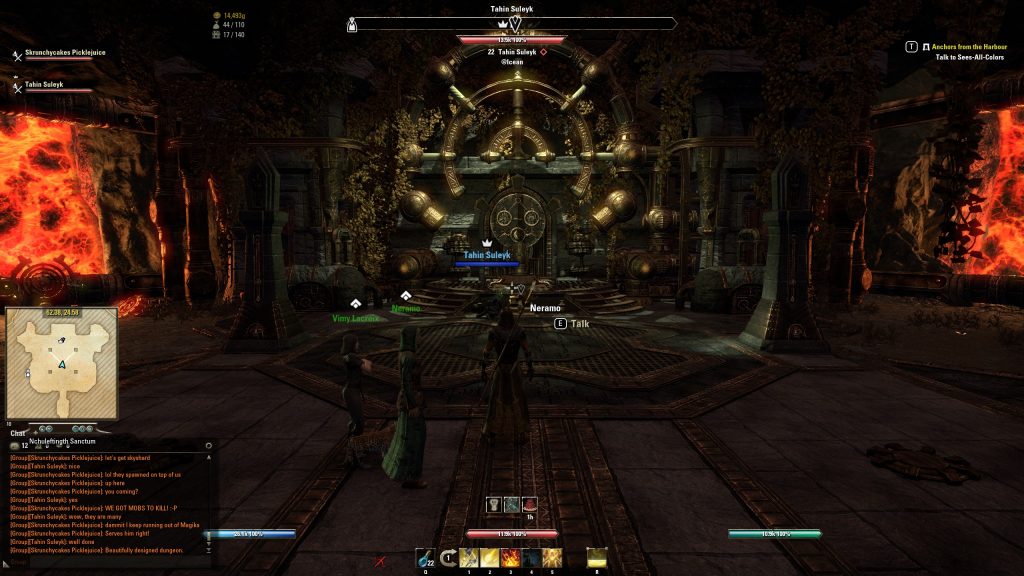
Content
With more than 25 years of evolution, the Elder Scrolls series has some of the most in-depth and rich lore of any MMOG on the market. I want to preface by saying ESO is more of a sandbox MMOG than one that follows the traditional model. This is one of the most important points that sets ESO apart from the competition; it’s not like other traditional MMOGs (i.e. WoW, FFXIV).
Immersion into the world of Tamriel begins with the Character Creation phase where the player chooses their Race; the character’s race also automatically defines their faction. There are 9 races to choose from, and each race has its own unique look, culture, and set of race-based skills which provide additional support of the chosen class. First, we have Breton, Redguard and Orsimer (Orc) as part of the Daggerfall Covenant faction. Then we have the Nord, Argonian (Lizard), and Dunmer (Dark Elf). These races are of the Ebonheart Pact. And finally we have the Aldmeri Dominion faction, which consists of Khajit (Feline), Bosmer (Wood Elf), and Altmer (High Elf). The creation process has quite a bit of variation in customizing the overall look of the character, but ultimately, most end-game players choose custom-built armor sets that often hide the racial traits and focus instead on gear visuals.
While Faction defines the starting location of a race, the main impact is for PvP allegiance and what side you will fight for if you choose to do faction-based PvP.
Like other MMOGs, each class in ESO is unique and has its own set of skills supporting differing play styles. There are six Classes to choose from. The Dragonknight is great at DoT damage and Tanking. Necromancers are quite versatile with death-based abilities, including temporary summoned minions. Nightblade is one of the most difficult classes to play efficiently due to rotation, but is great at sneaking past enemies and using poisons. The Sorcerer is probably the most friendly for new players and very tanky and forgiving while providing pet support. The Templar is also one of the strongest and easiest classes to play. Warden is very well-balanced, also providing pet support with mixed heals and damage. While a list of only six class options may seem quite limiting, the diversity in classes combined with racial, stat-focus, and other non-class skills allows for a wide variety of build variations.
Many people regularly ask “what’s the best new player friendly solo build currently in ESO?” It’s probably the Magicka Templar. It may not be the most exciting, but it’s generally held as the highest DPS and survival with the lowest requirements available. Here’s Hack the Minotaur’s One-bar PvE Magplar video guide for those who are interested.
ESO has excellent class balance. While there are builds that perform “top tier” relative to DPS in Trials and Dungeons, each class can be played to end-game, solo, and perform exceptionally well if properly geared and the right skill rotations are learned. As such, players can focus on the classes they enjoy rather than being forced into a meta build just because it’s so much more OP than all others.
One thing that makes ESO different from other MMOGs is how the Skill system works. While I cover the skill system in more detail below under Mechanics, here’s a quick overview. There are three types of skills: Active, Ultimate, and Passive. Both Active and Ultimate skills are action skills (which are executed or toggled) whereas Passive skills are exactly that – passive. There are 8 skill categories: Class, Weapon, Armor, World, Guild, Alliance (PvP), Racial and Crafting. It’s easy to tell in the UI if a skill is passive because it’s circular, where an action skill is square. Each skill belongs to a Parent Skill; Parent Skills track your overall expertise for that subcategory. For example, Two-Handed is a parent skill of the Weapon Category. While categories (like Weapon) have no number or skill-based value, Two-Handed does (1-50) and there are 5 Two-Handed skills that can be unlocked, leveled and used. Most parent skill lines also have an Ultimate skill (which charges as you fight). As the character uses two-handed skills, both the skill and the parent skill progress in level (parent skills are 1-10 or 1-50, and skills are I-IV). In order to increase the level of a skill players must acquire experience (via combat, quest rewards, etc.) while the skill is active. So actual use of the skill doesn’t provide XP; having it active when you get XP does.
Once a skill completes level IV, it can be morphed. This augments the skill and resets it to be leveled once again to level IV (as the morphed version). This allows for each skill to be morphed into 1 of 2 variations, taking the general number of skills under a parent from 5 to 15 (and 3 for an ultimate). A total of 12 skills can be slotted at any given time on a character; 6 on each bar (5 normal skills with 1 ultimate). Once a character reaches level 15, weapon swapping is unlocked, which allows for the switching between the two skill panels.

Class skills and Racial Skills are the only ones locked and available based on class and racial choice. All other skills are available to all characters (referred to as Global Skills). To put the diversity of class potential into perspective, every class can technically fulfill any role (Tank, DPS or Healer). In ESO Sorcerers can be tanks and Nightblades can be healers. That’s a pretty cool design. This means if a player falls in love with one specific class, they can build that class out to unlock every skill possible, and can then switch between roles based on need and adventure goals.
While there are a number of global skill lines, such as Weapon, Armor, World, and Craft, one of the most important categories is that of Guild skill lines. This is where we have the Fighters Guild, Mages Guild, Psijic Order, Thieves Guild and Undaunted skills. Most builds use skills from one or more of these. These skills are different from the others because they only go to level 10 and the parent skill is only raised by engaging in different activities. For example: the Fighter’s guild requires you to kill undead and complete Dolmans. The Mage’s guild requires you to seek out and find all of the Mage books in a zone. The Psijic order has a quest where you hunt down rifts and seal them. The Thieve’s guild requires you to commit crimes, and the Undaunted line requires you to complete dungeons and gain achievements. This is a very good design and requires the character to engage in exploring all aspects of the game in order to raise these skills.
Xynode created an excellent video covering how skill leveling works. You can watch it here.
Another thing that makes ESO unique is any race can use any weapon or armor type, along with numerous world skills, and thus raise the skills associated with them. This means you can build a heavy armor mage tank, or a light armor nimble assassin with a bow. While there are 8 core skill categories: Racial, Class, Weapon, Armor, Guild, World, Alliance War and Trade. The subcategories are numerous, and the game features some 394 total skill points that can be acquired; and yes, every one of them can be distributed and used on a character.
It’s also important to mention that characters can become Werewolves and Vampires, which include custom skill lines and the ability to play as a howling bloodthirsty werewolf or a bat swarm bloodsucking evil feeder. The upcoming Greymoor expansion (due for release next month) contains an overhaul of Werewolf and Vampire gameplay and skills, enhancing both greatly.
It’s important to mention that when it comes to groups and dungeons/trials, ESO follows the old-school role support structure of Tank, Healer and DPS. While the classes are diverse and can fulfill any role, these roles are still required and represent the traditional model.
The reality is most people play ESO solo, using the dungeon group finder tool or occasionally teaming up with guild members to tackle harder content or go after specific items they can’t acquire without a solid team. The good news is nearly all of the content in the game can be done solo except for Trials, which are the end-game raids that require a substantial group.
ESO is a role-players dream. Want to be a Skooma addicted Khajit kleptomaniac who prefers stabbing victims with poisoned blades? Check. How about a bear-riding Warden who uses insects and poison to destroy its victims, all while running like a jester dressed in a bathing suit? Check. While I admit ESO focuses more on the traditional role-playing standards than the weird, the diversity in gameplay styles, experiences and overall fun factor is top notch due to the sandbox nature of the game.
Mundus Stones are statue-like structures spread throughout the world which a character can attune with to receive extra benefits. There are 13 in total with some providing resistances, others recovery, and bonus damage. A character can only be attuned to one Mundus stone at a time.

Cosmetics are a big part of ESO, directly tied to crafting, achievements and the crown store (covered later). But players go to great lengths to make their character look the way they want, and it can be a very long journey due to the time it takes to complete end-game and long-term Achievements. The good news is once you’ve learned a style on any character (via motif), that look is available on any character through the Outfit Station. This is where a character can customize their appearance by selecting the visual for each piece of equipment they are wearing, including dying their equipment. Dyes are unlocked by acquiring them through quests, the market, etc. or purchasing them in the Crown Store. As with most games that have dyes, the most expensive/difficult to obtain are the absolute colors, such as black, gold and white.
ESO does lack “skins” for a number of things; for example, all of the twilight tormentors (Sorcerer pets) look the same. While we can buy armor sets, costumes, mounts, pets, and furniture, we can’t buy visual skill augmentations. That would be a great enhancement for the game.
As mentioned, for those who are interested, the Story of ESO is one of the most in-depth and well defined of any MMOG on the market. I’ll just leave it at that for those who don’t want any sort of spoilers.
Since ESO is more old-school when it comes to navigating the terrain, the the lack of parkour is very frustrating, often requiring the player to run around simple rock formations rather than go over them (as a game like BDO would allow).
As with many MMOGs, there are a ton of Items, including Weapons, Armor, Jewelry, Potions, Glyphs, Recipes, Soul Gems, Crafting materials and more… the list goes on and on and quickly grows to thousands in length. The game features more than 400 unique Item Sets that serve as the core for all character builds, each providing a different set bonus. Each set can be farmed in specific zones and dungeons. Sets generally require 5 pieces to complete, except when it comes to “Monster Sets” which are two-piece (Helm and Shoulder) items that are acquired through veteran dungeons and Undaunted boxes. The standard set layout for an end-game character is to have 3 complete sets (5+5+2) active. Characters can wear a total of 12 items; 7 pieces of armor, 3 pieces of jewelry, and 4 weapons (for swappable duel wield). Character equipment has quality (White to Gold), has a defined trait (bonus type, which is covered in more detail below under crafting), and a style (visual look). Items also allow Glyph Enchantments, which can easily be applied with a right-click.
There is an add-on called Dressing Room, which helps manage multiple builds (swapping skills and items with the click of a button). This is great for people who like to play one class, but as different roles based on what they are doing (PvP, Trials, Solo PvE, etc.).
Items have level requirements ranging from 1-50 and then CP1-160. CP represents the “Champion Point” end-game (account-wide) advancement system, which I cover in detail below under Mechanics. Items always drop at the level of the character, and once a character reaches level 50, items will drop at the CP level; but this is where things can get confusing because CP160 is the max level an item can be. For this reason, players generally do not want to farm items below CP160 once they make level 50 because those items will never be “the best” for crafting and improvement. So most players stick with their base L50 (or even 45) gear until CP160, where they upgrade all of their gear.
Items have Durability, which require Repair. This ties to the death system; while your items will lose durability through use, they do take big hits when you die. There are repair kits players can keep so they are able to repair in difficult dungeons and trials. If an item loses all durability, it becomes useless until repaired. The repair system is generally a minor money sink, and nothing more.
Items are either unbound, bound, or character bound. Unbound items can be traded and sold. Bound items can be exchanged between your characters on your account, and Character Bound items can not be transferred off of your character. The one exception is for items that drop in a dungeon; you have the ability to trade them with other people that were in your party, but only for 60 minutes. After that, they revert to Bound. The nice thing about this system is if you find a very valuable item (such as a Set item or Weapon), you can freely transfer it between your character. Rarely are items Character Bound (most of the time it’s crafting recipes, etc. that are rewarded through quest completion; something that is very character based).
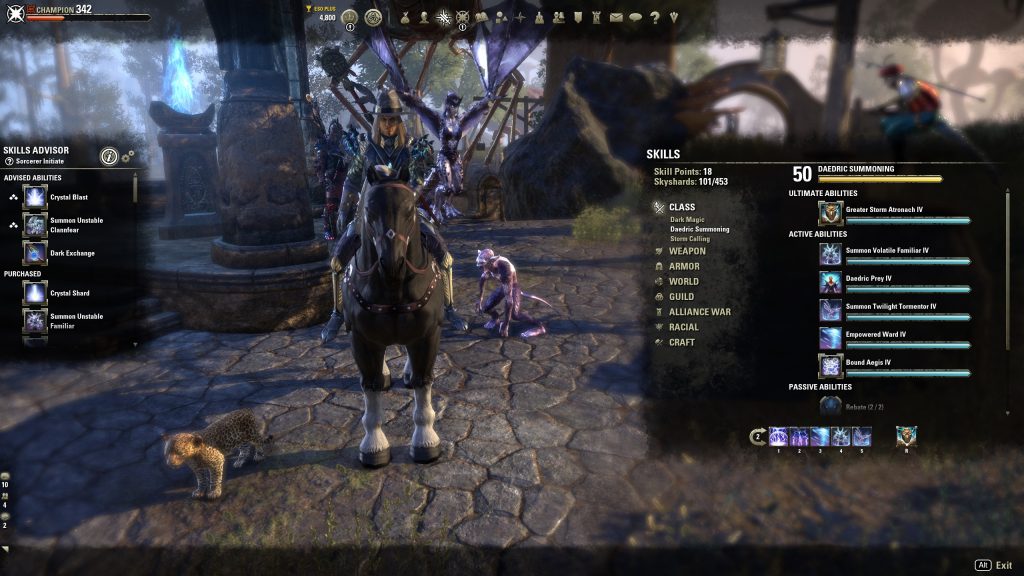
There are more than 2,000 quests in ESO, and each has its own voice acting (which is usually quite good). Some are simple 1-2 step quests, while others are epic and have numerous steps. Each zone also has a zone guide, which is very useful for new and returning players who want to focus on completing everything a specific zone has to offer (which can offer dyes, titles, and other rewards). Glancing at each Zone’s guide shows she sheer volume of content there is to explore. A complete list of quests can be found here.
When ESO first launched, they followed the traditional level-zone based system where a character was restricted as to where they could survive based on their character level. Bethesda realized this was a flawed design and did not match the sandbox play style of ESO, so they executed a complete overhaul of the game’s mechanics and made it so any level character could adventure through nearly every zone in the game. There are tougher monsters and zones that most new characters should stay away from, but for the most part, a player can enjoy and experience the majority of content regardless of their level. This emphasizes the fact that ESO is all about the adventure.
The world of ESO is huge. There are 39 Zones, 269 Wayshrines and 42 Cities in the world of Tamriel. This includes more than 150 custom mini-dungeons (Delves), 3 Dolmans (group events) on average per zone, and 25 public dungeons (in total). In addition to the diversity of zones and environments, each area has specific gear can that drop, so if a player wants to pursue acquiring a certain item set, the can farm the associated region to obtain the gear. The game also features day and night cycles complete with weather (rain, dust storms, and snow). The cities and towns are always thriving, there are numerous quest hubs in each zone, and multiple places of interest.
ESO also has the Maelstrom Arena, which is an end-game multi stage event that is considered to be some of the most difficult solo content in the game (namely in Veteran mode). Completing the Arena on Veteran difficulty can reward some of the best weapons in the game, so experienced players strive to create characters capable of completing the arena on veteran mode. And yes, it’s tough. For those who are interested, AlcastHQ has a great guide on beating the Veteran Arena.
When a character grows in power, the player can start running Veteran versions of the dungeons, which are much more challenging. The end-game most difficult content available is the 12-man Trial raids, of which 8 are currently available. Public dungeons are open to anyone who wants to adventure and play with random people while private dungeons require a group (or can be run solo if a character is strong enough), but will never have random people showing up like they do in Public dungeons.
One poor design is when you complete a dungeon, there’s usually no easy way out; you either have to run out, or spend money to port out. Why they haven’t added an exit portal when the activity is complete is beyond me.
ESO is all about exploration, and characters are always rewarded for going somewhere new. Whether it’s harvesting nodes, hunting down mage guild books, skyshards, or getting delve completions, there’s always something to do, and the world exploration achievements are character-based, so the player has to re-explore the gaming world with each new character. This may sound cumbersome, but the game is so vast, enjoyable, and rewarding when it comes to exploration, building a new character and running them through the world again is just fun.
Harvesting materials for crafting is easy; in ESO you don’t need any harvesting gear – any character can farm any node. There are also Treasure Chests spread throughout the world ranging from Simple to Master, many which must be lock-picked. For those who love going after caches of loot, Treasure Maps take you to a place where you can dig goodies up, and they are often quite valuable. There are also Survey Maps, which are provided as rewards for doing Daily Crafting Writs (covered below). These areas have an abundance of materials for farming.

The world of Tamriel is packed full of nasty Monsters including Animals, Demons, Machines, Undead, Bugs, Giants, Humanoids, Magical creatures and more. This include Champions (which are generally found in dungeons as bosses) and World Bosses, many of whom provide an Achievement and require a group to kill. But it’s also important to talk about the interactive NPCs who provide quests and often run up to you asking for help. This makes the world feel much more alive than other MMOGs.
ESO features two types of Pets: combat and non-combat. Sorcerer, Necromancer and Warden each have skillines that provide for summoned combat pets, with the Sorcerer being the most pet-heavy class in the game (that can technically have 4 out at once with a set and ultimate). Non-combat pets are merely for show and collections.
Player Housing is a fun feature for those who want to create a place to call home. With a selection of 40 unique homesteads (ranging from Apartments to Manors), players can purchase, craft and place numerous items (furniture, collected statues, etc.) throughout their home. Home ownership is account wide, and an account can own one of each type of available home. Players can also place crafting stations, mundus stones, and merchants, etc. in the home. A player can also teleport to any of their homes for free at any time. Homes also provide extra storage space with a total of 240 additional slots.
The Tutorials & Zone guides are well designed and help guide new players in the right direction to learn about the gigantic world of Tamriel. The only key thing missing is ESO should really auto-install certain add-ons, which really are required to play and enjoy the game (note I cover them below).
The game has DLC (Downloadable Content) and Expansions, which must be purchased. The ESO+ subscription provides access to all DLC, but each expansion must be purchased. ESO+ provides access to all downloadable content, but not expansions.
The purchase requirements of ESO are not new-player friendly when it comes to making a financial investment in the game, because it’s confusing as to what a purchase acquires and what is not included. The quick of it is this: ESO+ (discussed below) provides access to all DLC, but you must purchase all expansions (and the base game). If you don’t have ESO+, you must also purchase the individual DLC you want access to.
There are numerous Titles available for your character, and each one requires the completion of a specific achievement. And when I saw ESO has a lot of Achievements, I do not exaggerate. I’m not sure of the exact number because they are not linear in acquisition; achievements provide a number of points ranging on average from 5 to 50 and there are more than 40,000 points that can be obtained.
Players can purchase and unlock (generally through Achievements) Collections for their account (and thus every character). This includes Appearance (costumes, skins, etc.), Furnishings, Assistants, Mounts, Pets, and Emotes. There’s always something to strive for; an awesome armor skin, or a cool mount. Some Collectibles are event only and no longer available (i.e. they were a one time offer tied to some prior event). Others are available when an event comes back (i.e. the Christmas event).

Gameplay & Mechanics
ESO uses a player-scaling technology called Megaservers. This real-time system ensures cities and dungeons are never too empty or overcrowded; and it works very well. I’ve never felt alone in the world, nor have I felt like I needed to escape the vast number of players in my area. The balance has always been just right, and the game is very much alive and well (and continuing to grow).
ESO is a level-based game, where the max Character level is 50. But once a character hits 50, the Champion Point (CP) System is unlocked, which is the Alternative Advancement (AA) system of ESO, and global for all characters on an account. This means a brand new character on an account with a high CP can distribute their CP points at level 1, making them much more powerful than a normal level 1 character. Many new players see other low level characters destroying content at a much more efficient rate than they can and often wonder why. It’s all in the CP. The max CP level is 810, and each level provides a point in one of three categories: Warrior, Mage and Thief. Each category has three subcategories supporting the base. Warrior nodes enhance physical damage, resistances, etc. Mage nodes enhance magicka regeneration, elemental damage, etc. and Thief nodes enhance Sneak, dodge, and recovery of stats, etc. While the current cap usable CP points is 810, players continue to build their Champion Level as long as they play. I’ve seen players with a CP score higher than 2,000. As such, there is the potential for Bethesda to raise the spendable CP cap beyond 810 in the future.
Once the CP system has been unlocked, an account gains Enlightenment every 24 hours, which provides 4x the CP leveling XP until it’s used up. This is essentially rest bonus, and applies only to the CP system.
With each Level, a character is provided with a set of leveling rewards, which can include weapons/armor and extra skill points. I really like they way they implemented this system; it emphasizes the rewards for leveling your character and provides a snapshot of what is to come.
There is some confusion about how Skill leveling works. Your skills (and their categories) gain XP when you kill a monster; but not just with the skill you used, the XP applies to all skills on the hotbar that was active when you made the kill. If you use a skill from your 2nd bar (say a DoT that ticks) and switch to bar 1 and the target dies, only your skills from Bar 1 receive experience, and your skills from Bar 2 will not (even though you used a bar 2 skill on the target). The XP is evenly distributed across all slotted skills (1-5 and Ultimate). So if you want to raise a specific skill category (say Destruction Staff) as fast as possible, you want to slot as many skills from that category as you can since the XP is evenly distributed across the slotted skills. But this can be difficult because the game is designed to require skills from multiple categories to make a character viable for play and survival. As such, most characters end up having only one skill per category active on their hotbars as they level. Another important note is not all skills level at the same speed; skills with higher level requirements are generally slower to level up because they require more XP per level.
You can raise parent skills as you adventure throughout the world by reading from bookshelves!
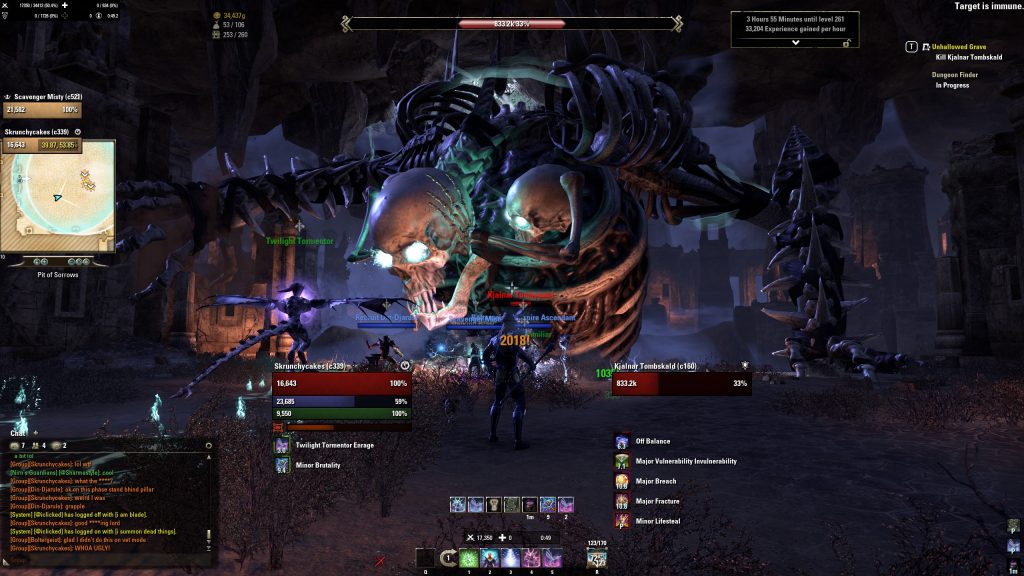
ESO has simplified the core Mechanics so many other games have overly complicated, and it works very well. For example, there are only 3 character stats in the game: Magicka, Health and Stamina. Builds are either Magicka or Stamina-based, and there are hardly any health-based builds. There are only two base damage types: Spell and Weapon. While there are elemental and DoT based damage types, each is converted to one of the two damage types. Magic, Flame, Frost and Shock are converted to Magic Damage and mitigated by Magic Resists. Physical, Bleed, Poison and Disease are all Physical Damage and mitigated by Physical resists. It’s that simple. There are no multi-elemental resistance requirements for gear; just core resistances. I really like this simplified approach. There is also Critical and Penetration (Physical and Magical) that helps multiply damage and ignore a percentage of a target’s resistance. The game also features Damage Shields, which are a big part of surviving boss fights and tough encounters. It’s interesting one of the tankiest builds in the game is the Sorcerer, showing the difference of ESO and diversity of the skill-based system compared to other MMOGs, which have class roles etched in stone; something ESO does not.
ESO has a newer generation of fluid Combat than the traditional tab-based MMOGs like WoW or FFXIV. While it’s not at the same level as a game like Black Desert Online (BDO), it’s flexible enough to enrich the combat experience with dodges, light and heavy attacks, blocking, and interruptions. End-game combat is all about perfecting your rotations and weaving your attacks. This is actually more difficult than is sounds due to the interactive nature of Combat. As such, the game features two types of attacks: Light and Heavy. Light attack weaving is a method of animation cancelling, and Heavy attacks are designed to regenerate resources (Stamina, Magicka, and Health). The only way to obtain end-tier DPS is through advanced weaving, and for those who want to master this method, it’s always good to watch a video and practice on training dummies.
The combat disengage feature with monsters in ESO is a very poor design. Mobs will follow you way too far and will not disengage until you hit them or until they hit you. This means you often have monsters trailing you, and you turn to attack and on the first hit they “reset” and move back to their location. It really is a terrible design.
Monster Mechanics become an important part when the player starts diving into dungeons, with the most complex mechanics being in Trials. ESO features the standard “red on the ground” painting for area effect damage (incoming and persistent) but also shows different incoming attacks by monsters, some of which can be interrupted. Stamina is required for both Blocking and Dodging attacks, and interruption.
I recommend Alcast’s guide on Animation Cancelling and Weaving for those who are interested.
Travel consists of running, using Wayshrines and teleporting to your home, friends, party and guild members (and their homes). One of the best advantages to being in a guild is the ability to teleport to somebody for free who is in an area you haven’t been to but need to unlock.
Mounts are a big part of the game and each character can train a 1% increase in mount Speed, Stamina or Carry Capacity every 20 hours for 250 gold. With the maximum being 60%, this means it takes at least 150 days (5 months) to train a character’s mount to max level across the board. The good news is this training applies to any mount that character chooses to use, but mount training is specific to each character, and not global for the account.
Mounts are account-wide acquisitions and can be used by any character!
There are numerous Consumables in the game including potions which buff you during combat, food which provides long-term (2 hour) benefits, experience gain scrolls, and more. Food is the greatest consumable asset in the game, often making or breaking the sustainability of a build. Potions last under 60 seconds, but can augment damage to a level that can alter the outcome of a battle.
Death causes equipment durability loss, but no experience loss. The game also allows the use of Soul Gems to resurrect on the spot, or the player can raise at the nearest wayshrine. Players are not permitted to resurrect during boss fights except through another player executing a raise action. I like the fact there is no character progression loss on death, but if you are in a dungeon/trial and die at a boss, you can only be raised by another player or wait until the group wipes (thus resetting the boss) before you can resurrect.
Crafting is one of the strongest features of this game. By using crafting stations for Clothing, Blacksmithing, Woodworking, Enchanting, Alchemy and Cooking, players can make thousands of different items, with a focus on style (visual), traits and quality. Crafting is character-specific, so most players who plan on becoming end-game crafters usually focus on one character for learning everything possible with crafting, which (no joke) takes years. This is done through research, which requires items with the specific traits to be absorbed; and the most difficult traits can take up to 30 days to learn. Deconstruction is the standard for acquiring crafting materials. A player can deconstruct nearly any item to obtain its components. Improvement increases the quality; this allows a player to take a low quality (say Green) item that has the trait they want (say Divine) and upgrade it to Yellow (perfect). So when a player wants to hunt for a specific armor set in a dungeon, with crafting, it doesn’t matter what quality of armor drops; it can always be upgraded to the highest quality. There are also numerous passive crafting skills a character can invest in that greatly increase the efficiency of crafting, deconstruction, refinement and research.
Players can not only craft and upgrade the quality of items, they can change traits through Transmutation. This feature requires Transmute Crystals, which are acquired through dungeon/undaunted pledges, the daily random dungeon, PvP and other holiday events. The solid part of this design allows a player to take their favorite item and invest time and energy to make it perfect for their build.
The game also provides Daily Writs for crafters, which are essentially the daily crafting quests. They raise a character’s crafting skill level, provide materials and bonus rewards such as survey maps, which point the character to locations of abundant harvesting nodes.
ESO allows characters to be thieves and murders; not to other players but to NPCs. Characters can steal, murder, sneak, become a fugitive, have a bounty placed on their head, and sell stolen goods to a fence. One efficient way to make money is to create a thieving loop a character runs each day. Careful of the guards!
PvP is very popular in ESO, and can be a lot of fun, but it can also be very unbalanced. The main reason is because characters specifically built for PvP are quite different from those built for PvE. As such, many players who enjoy the casual nature of ESO PvE solo play find themselves utterly destroyed in battlegrounds. For this reason, most players who want to do PvP build characters specifically for that. ESO features instanced battlegrounds (available through the finder system), and the open war zone of Cyrodiil, which supports alliance-based PvP. Since there is a reward for completing a daily PvP battleground and some of the PvP skills are very useful in PvE, nearly all players are enticed to endure the grueling reign of death from experienced and PvP oriented builds just to get a nice boost in XP and help unlock the Alliance PvP related skill line.
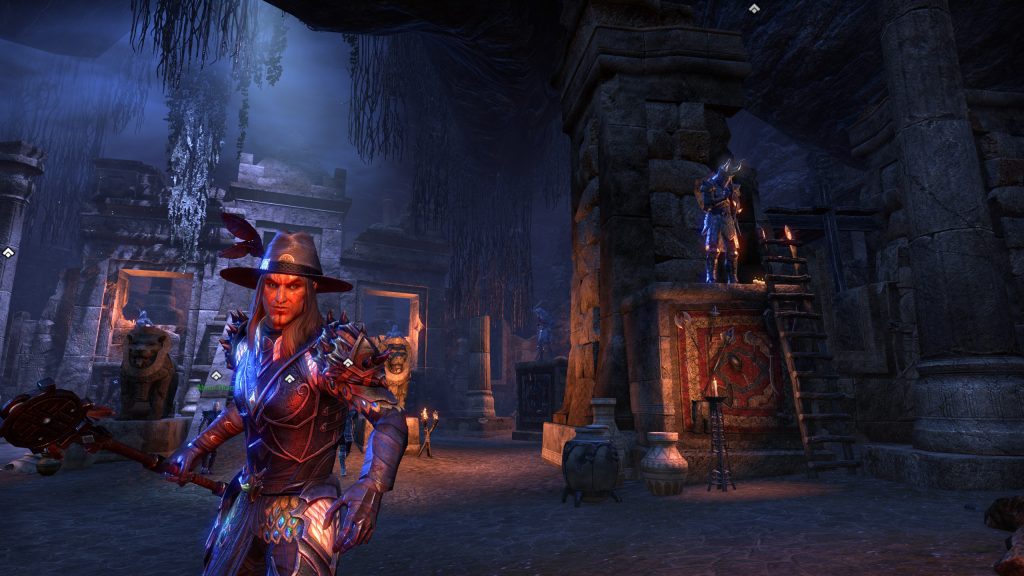
Economy
There are many different types of Currency in ESO including Gold, Crowns, Crown Gems, Event Tickets, Transmute Crystals, and Undaunted keys. Players can sell crowns for gold and vice verse, which creates the connection between real money and in-game currency. Gold isn’t too difficult to get, but it’s quickly gobbled up by crafting and purchase costs of equipment, which is the real money sink. I will cover the other currency types below in the systems they apply to.
The Crown Store is the RMT system of ESO, providing numerous enhancements and visual upgrades for players who want to sped real money. There are also unique quest chapters, mounts, non-combat pets and assistants (such as a merchant or bank NPC that can be summoned at any time). The good news is none of the content is P2W and all of it is either visual or enhancing for things like XP gain. Players cannot spend real money to obtain an advantage over others except for the ability to purchase in-game gold (through crowns) and thus acquire better gear. But for somebody who wants a Trial set, there’s no way to purchase that. Players can easily gift crown store items to other players.
The current Gold to Crown rate varies in the US from 250:1 to 175:1. With a 250:1 rate, 250,000 gold buys 1,000 crowns, or $10.
The cost of purchasing crowns directly is: 750 for $8, 1,500 for $15, 3,000 for $25, 5,500 for $40, 14,000 for $100, or 21,000 for $150.
Crown Crates are the RMT gambling mechanic that can provide some of the best visual and enhancement items in the game, such as mounts, potions, XP scrolls, pets and more. But, as mentioned, it’s gambling. Crates are awarded every month to ESO+ subscribers, or they can be purchased for Crowns (real money). Crown Crates are the gateway to Crown Gems, the RMT currency that allows the players to purchase items that require gems from the Crown Store. Crown gem items are usually not available for purchase with Crowns, and are often the best looking items in the game; of course this is by design since it entices people to spend more money to get the items they want (through gambling), but the system of awarding gems for duplicate or unwanted items and then being able to use those gems to purchase a mount or pet you choose isn’t a bad design for those willing to spend the cash.
Many people ask what they should purchase first from the Crown Store. The general consensus is the Bank and then the Merchant. Each of these cost 5,000 crowns, so you’re looking at a 10,000 crown investment to get both.
Let’s talk about the ESO+ Subscription, which is $12.99/month (for 6 months) or $13.99/month (monthly). In my opinion it’s worth every penny, and a must have for anyone who really plans on playing the game. It provides access to all DLC, 1650k crowns per month (or 9900 instantly for 6-months), monthly crown crates, a craft bag, double bank space, bonus XP, Increased housing item placement count, costume dying, double transmute crystal capacity, and access to unique ESO+ only Crown Store deals.
Character Inventory Size is an important part of ESO because it’s so easy to run out of space. While each item takes one slot, the maximum number of slots a character can purchase for gold is 110. On top of that, the player can unlock 60 more slots through increasing mount capacity at the stable (1 slot every 20 hours). While 170 slots may sound like a lot, it really isn’t. This is where ESO+ comes into play. One of the best features of ESO+ is the material bag, which stores all harvested materials; and to say there are a lot is an understatement – the game is really unplayable at end-game without the ESO+ material bag. For reference, I can fill my character’s entire inventory with items to deconstruct in less than 30 minutes (running a public dungeon), and that’s with the ESO+ material bag. There are also Bank Slots, which can be upgraded to 240. But the bank quickly fills up with leveling and set gear for different builds, as well as items with traits for crafters to research. The total cost to upgrade your bank slots to 240 is $768k gold. The good news? ESO+ doubles your bank slots for a maximum of 480.
One nice feature is the ability to Lock Items; this prevents an item from being sold, traded or modified (without an explicit permission dialogue confirmation).
Trading is available through three mechanics; Player to Player (Direct), COD Mail, and Guild Stores. Unfortunately, ESO does not have a real auction house system. Yes, there are guild traders, but they are a poor excuse for a global auction system, and visiting the traders doesn’t enhance the game at all (it’s actually quite cumbersome). Everyone uses (and relies on) a 3rd party tool called the ESO Global Trading House. When players have to rely on an outside tool for a feature everyone wants but doesn’t inherently get with a game that’s more than six years old, that’s a design flaw.
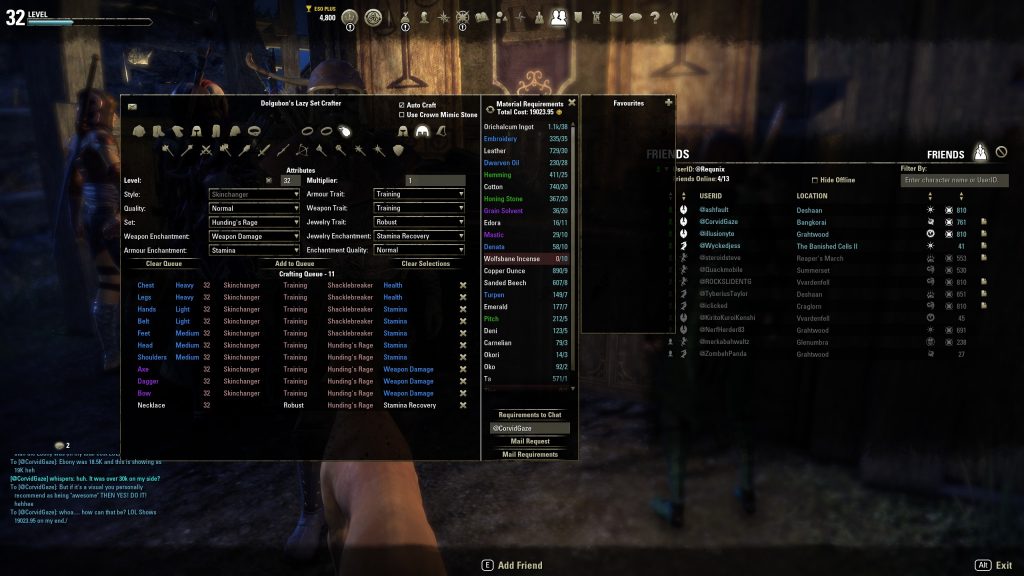
Community
Compared to other fantasy-based MMOGs, it seems ESO consists of older, more mature players. Most people I’ve met in the game are in their 30’s or 40’s, and there is far less drama in the zone chat than a game like WoW or FFXIV.
As we can see from the Steam Charts, ESO has clear steady growth over the past few years, showing the game is doing very well and continues to not only bring in new players, but retain old ones. This emphasizes the reality that ESO offers a world people want to either stay in or come back to, which is key for any online persistent game.
Guilds within ESO are mini-communities focused on player communication, collaboration and trading. Joining a guild is account-based, so all characters have guild access. There are no direct benefits provided by a guild (such as bonuses to stats), but players can join multiple guilds at a time (up to 5), gain access to the guild traders for selling items, and also have access to the Guild Bank. A character can also teleport to any other guild member for free at any time. This includes access to the guild leaders stronghold, which often has all the mundus stones, crafting stations and training dummies. Guilds also allow for securing castles in PvP. Players can also equip a custom designed Guild Herald, visible over their armor.
The Dungeon Group Finder organizes 4-person groups. It works fairly well, but more often than not, a player will decline and send the group back into the “front” of the queue to wait a few minutes more. It takes DPS on average 20 minutes to find a group for a normal random dungeon, but tanks are almost instant with healers also in high demand (and often in a group within 5 minutes or less). The good news is a pre-created group of 4 can queue up and instantly access any dungeon, which makes it very easy for guilds to organize dungeon runs.
ESO also has a Battlegrounds Group Finder for those who enjoy PvP, namely Deathmatch, Flag Games, and Land Grab. Unfortunately, you can’t enter the Battlegrounds Group finder with a pre-organized party, so prepare for solo mayhem!
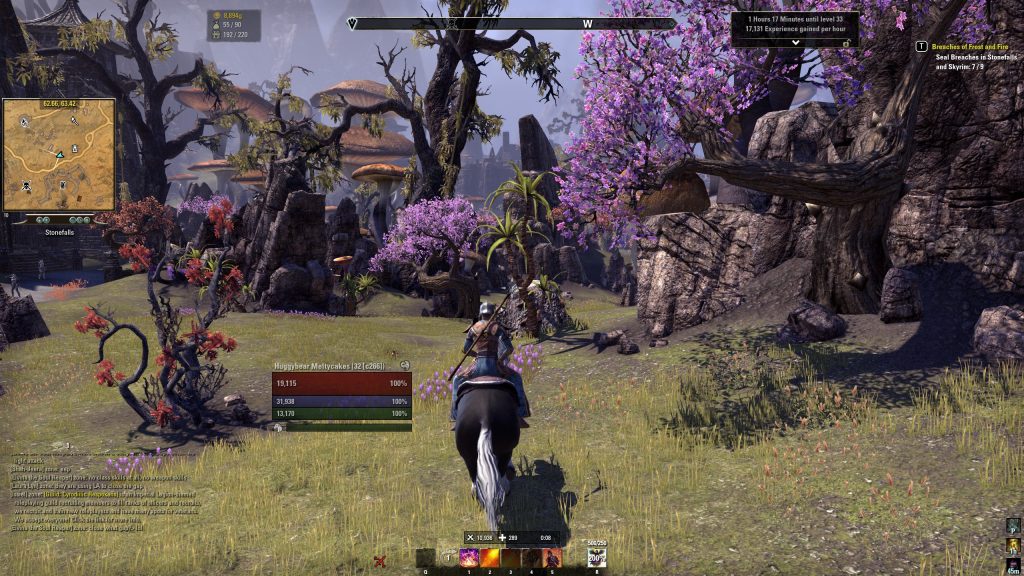
Technical
The Graphics of ESO are very good for a game that is six years old, with the majority of impressive visual coming from ambient environments (fog, sun, terrain, etc.). Coming from Black Desert Online (BDO), which is held to have some of the best graphics fantasy MMOG graphics, I didn’t feel as if I downgraded or started playing a game that was greatly outdated. I will admit the textures and terrain design of some of the starting areas are showing their age, but the newer areas are beautiful, and some of the dungeons are simply stunning in visual design.
The Sound of ESO is nothing exceptional, but the one thing worth mentioning is that every quest in the game is voice acted; and very well. The Music in ESO is essentially background music, and there aren’t any pieces that really stand out. It’s average, but not defining.
The User Interface is fairly basic, but Addons are critical for those who decide to play ESO for the long-term. The best tool to manage addons for ESO is Minion. Even if you are on the fence as to whether or not you want to commit to this game, I highly recommend installing it since it’ll make activating addons fairly easy. Here’s the official link to download Minion. While there are numerous well-developed addons to choose from, my personal opinion is the most important ones are Map Pins, LoreBooks and Skyshards. There are also combat metric, daily crafting, writ, and treasure hunting addons that are also very useful.
Arzyel wrote a great overview of recommended addons just a few weeks ago; here is a link.
When it comes to Connection, the Megaserver architecture is solid; I’ve rarely been disconnected, and have never encountered any latency that affected gameplay (US West Coast). However, as covered below, the biggest issue is with load screen times, and I believe that’s associated with the Megaserver shard technology queuing and moving players around.
There are a number of Bugs I’ve encountered while playing ESO:
- The loading times of this game are abysmal, and probably the number one complaint of all players. This is in part due to the megaserver system that distributes a player’s shard in real-time during a zone transition, making the connection issues even more apparent during prime time.
- Mail issues are probably the second most common complaint. Have a friend who sent you some items in the mail? You often have to change zones for it to show up. There are times mail has taken more than 10 minutes just to show up, regardless of zoning. There really is no excuse for the performance of the mail system.
- There is a bug where if you get knocked off your horse, you cannot execute any skills for 10-20 seconds. I’ve also seen this bug in dungeons where a quest transition takes place.
- Every once and awhile, the ability to loot a corpse disappears and the only way to get around it is with /reloadui.
- One of the legacy issues we’ve seen for more than a decade in other MMOGs is the bug that tells you that you’re in combat when you are not, so you cannot port or mount. This occasionally happens in ESO.
- Sometimes, the Dungeon finder will pop up the “ready” interface while you’re in the middle of combat and somehow you get removed from the queue (losing your place in line) and placed in a 15 minute penalty cool-down.
Those are the issues I’ve personally encountered, but none of them have prevented me from playing and enjoying the game.
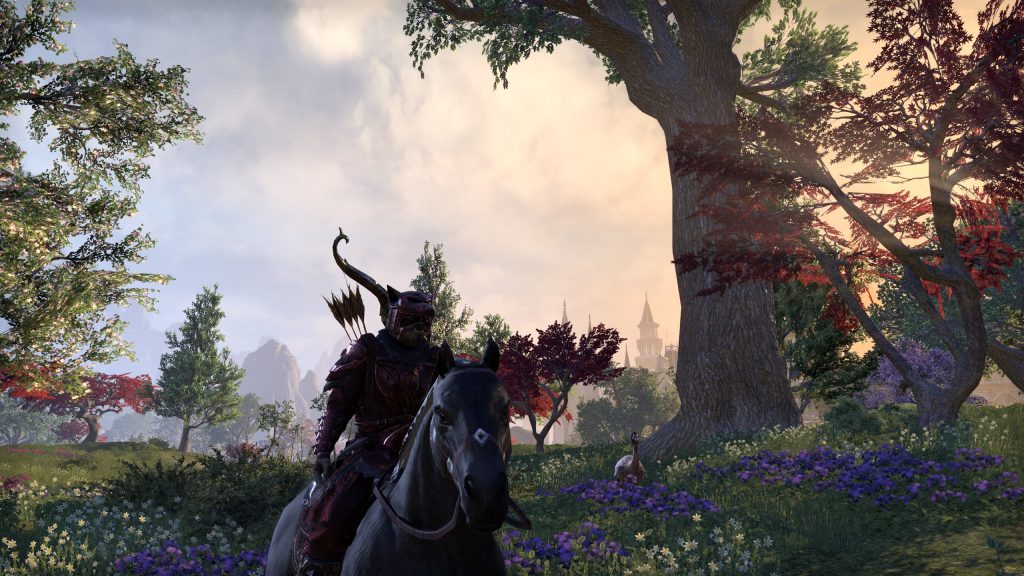
End Game
One of the most important things a MMOG must do right is not only attract, but retain its players with enjoyable end-game content that allows for hundreds, if not thousands of hours of gameplay. While the core of what ESO has to offer is a monumental volume of content, there are many systems and mechanics in place to support the pursuit, experience, and enjoyment of continued play once a player hits level 50 with their character. The good news is the journey to 50 is quite enjoyable as well, with many different approaches one can take to level their character.
Once a character hits level 50, there are a number of end-game options available:
- Raising CP to 810. This takes on average 6-12 months with regular play.
- Questing / Daily Quests / Pledges / Daily Dungeon / Daily Battleground.
- Building alternative builds (including trying Magicka vs. Stamina).
- Farming Skillpoints.
- Farming CP (Daily Randoms, Enlightenment).
- Farming Gear (Collecting Sets).
- Farming Gold (to buy gear, motifs, etc.).
- Exploration.
- Crafting (Daily Writs, Research).
- Maelstrom Arena (Solo).
- Trials (Raids).
- PvP (Solo or Alliance in Cyrodiil).
- Daily Login Rewards.
In other words, there is plenty to do. I’ve met numerous people who have been playing for years, and they only play ESO and many claim they haven’t taken any breaks. That’s impressive. Most of these players are CP1000+ and still enjoy the content and general play. That says a lot about the game.
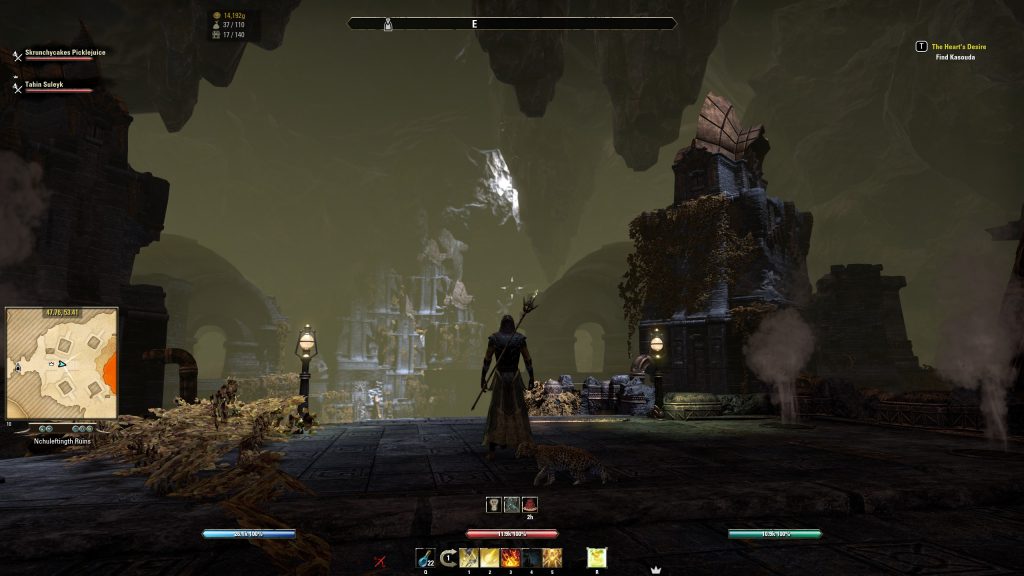
Conclusion
ESO is a very good MMOG, and the long-term growth of the player base represents its quality, ongoing evolution, and community support. The players are friendly, combat is fluid and fun, crafting in-depth and well-designed, and the volume of quality content is quite extensive and impressive. As such, there is always something to do. The long loading screens can be frustrating, and the price point can be a bit intimidating for new players, but for the initial $20 purchase price, the game offers more than enough to warrant the investment. ESO also hosts occasional free to play events for those who want to try it out before making a financial commitment.
If you’ve read all of this and are on the fence about whether or not you should buy ESO for $20, I highly recommend the game. If you are on the fence as to whether or not you should buy the subscription, it’s well worth the $12.99/mo. Additionally, the Greymoor expansion is right around the corner; it brings new zones and dungeons, monsters, items, redesigns vampires and werewolves, and the Antiquities system, which allows players to scry for ancient relics to obtain powerful items.
Here’s to a bright future for ESO, one of the best MMOGs currently on the market!
Resources
- ESO 20 Tips for Beginners (May, 2020): https://www.youtube.com/watch?v=z8HdJ-KYf2M
- AlcastHQ Compendium of Solo Builds: https://alcasthq.com/eso-solo-builds-how-to-solo-play-elder-scrolls-online/
- Free Skins, Costumes & Hats in ESO: https://www.youtube.com/watch?v=UrFUc8jBdrk
- ESO Simplified Daily Routines: https://www.youtube.com/watch?v=EObu-UHb3Pk
- Xynode’s Skill Leveling Tutorial: https://www.youtube.com/watch?v=VvBFzjxYzJw
- Xynode Light & Heavy Attack Tutorial: https://www.youtube.com/watch?v=xVKf2XbFDo0
- AlcastHQ’s Guide on Beating Veteran Maelstrom Arena: https://alcasthq.com/eso-maelstrom-guide/
